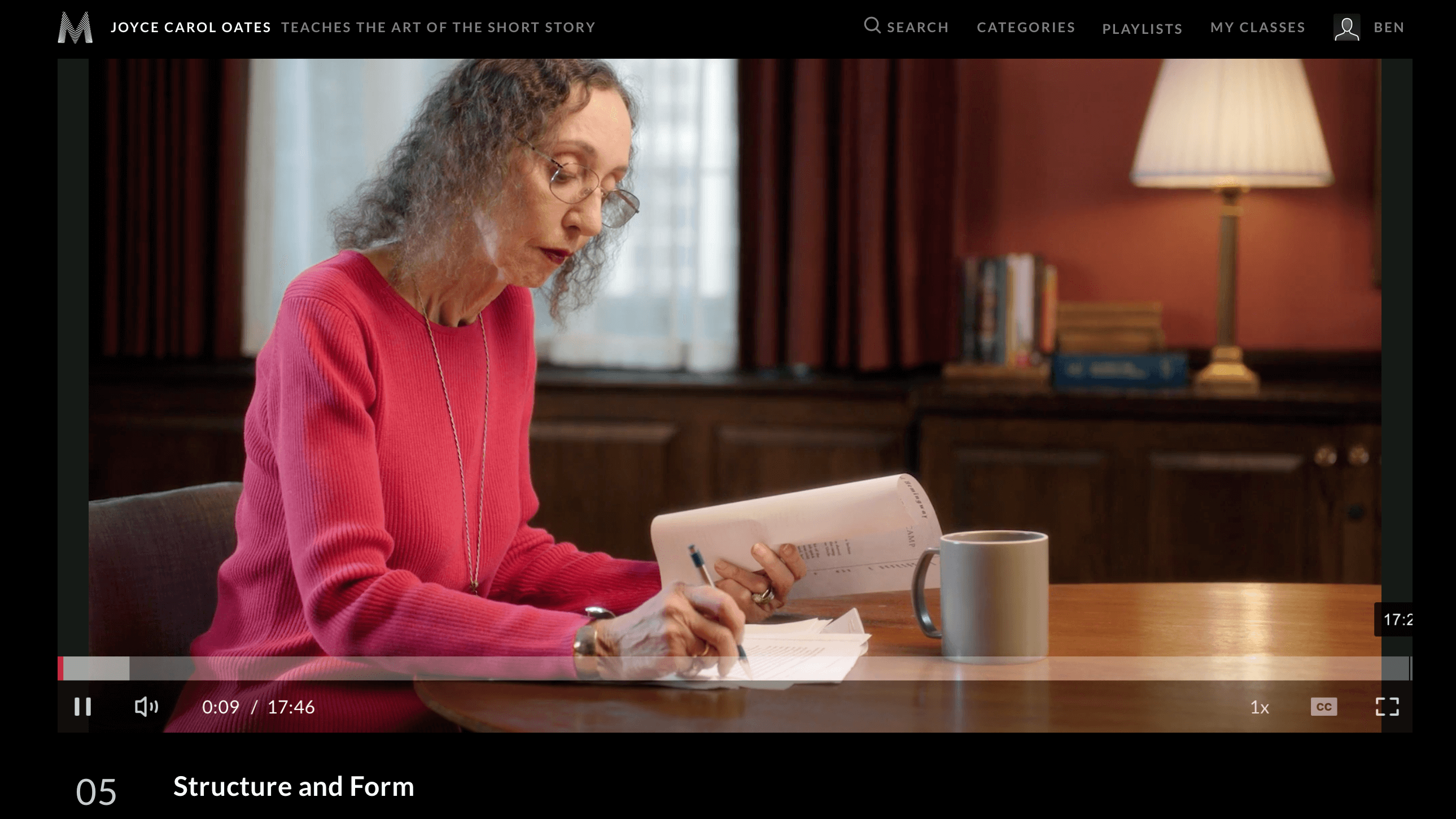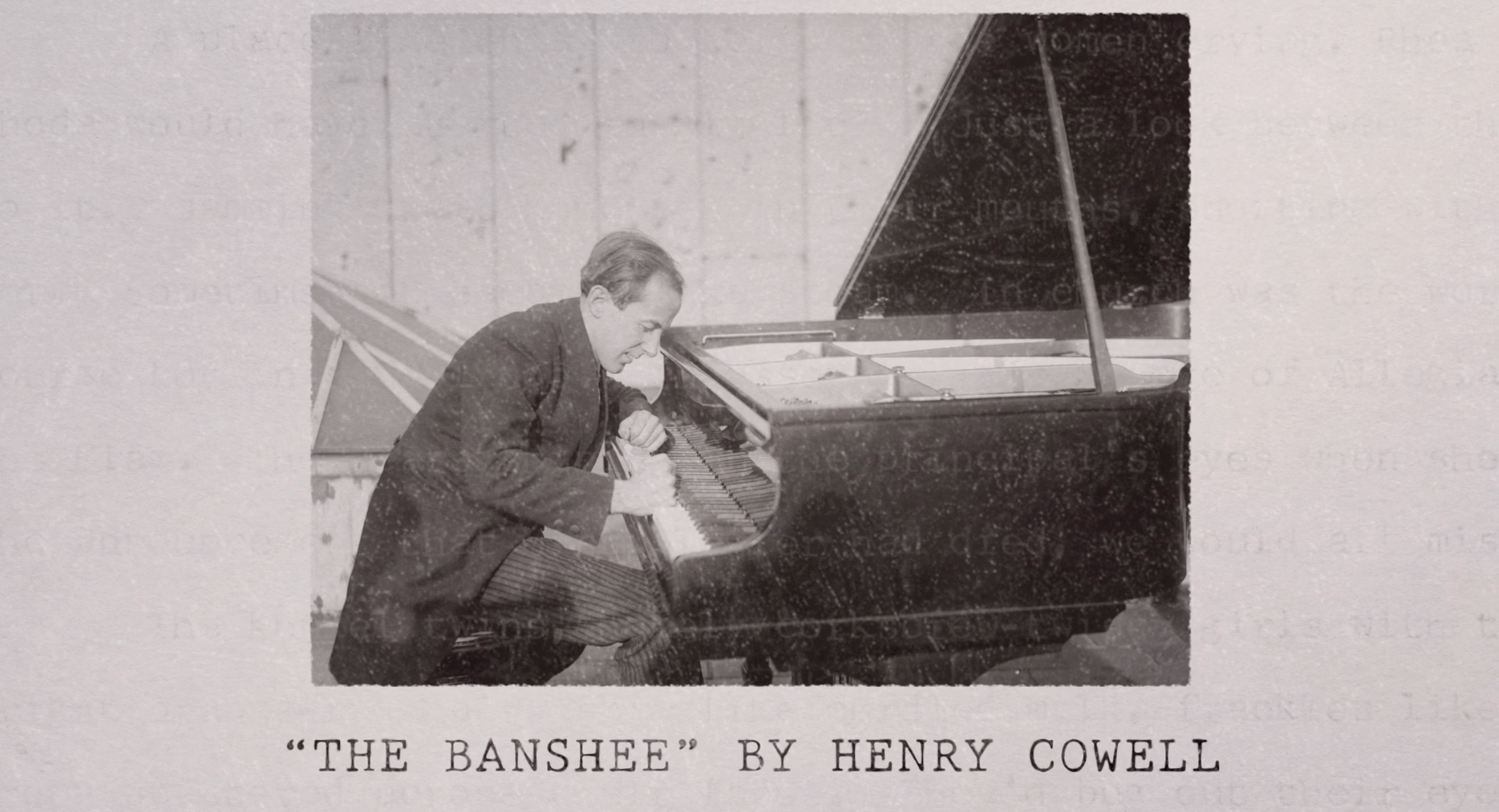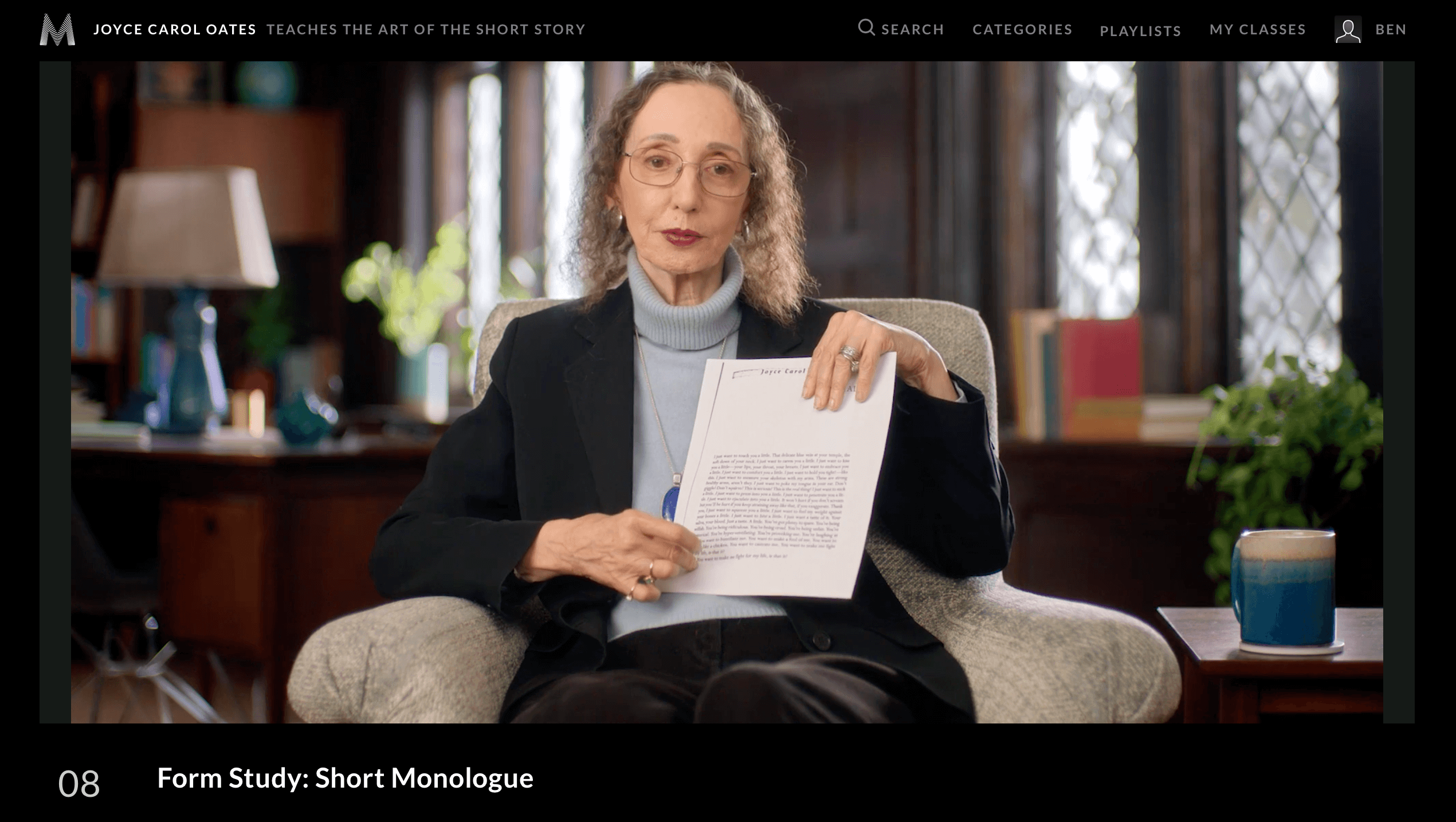The Joyce Carol Oates Teaches the Art of the Short Story MasterClass came at the exact right time.
MasterClass are masters of serendipity. It’s right when I embark on a mission to write a string of short stories that they announce one of my writing heroes Joyce Carol Oates is going to teach that very subject – how to write short stories.
Why take the Joyce Carol Oates MasterClass?
Well aside from my advice for you to go read one of her books so you can have that question immediately answered, I’ll offer you the fact that Joyce Carol Oates is one of those rare writers (I actually can’t think of another right now) who is both extremely prolific and extremely respected in literary circles.
Usually you have one or the other.
Writers typically sacrifice literariness for massive output, whilst others will keep their literary colours but their output is low.
Joyce Carol Oates has both – a huge catalogue of wonderfully literary books.
In addition to that, Joyce is commercially successful as well as being an artist through and through.
Simply put, there is no better writer from whom to take advice from when it comes to the craft in all its aspects.
Joyce Carol Oates Teaches the Art of the Short Story MasterClass Review
A born writer wants to tell a story – Joyce Carol Oates
The Joyce Carol Oates Masterclass follows the format and syllabus of Joyce’s undergraduate fiction writing class at Princeton University.
I would have paid a hefty price to have gotten into Joyce Carol Oates’ Princeton writing class. But, luckily, thanks to MasterClass, anyone can enrol!
Joyce Carol Oates dives right into the good stuff.
We learn about how to craft characters and treating them as though they were actors in a play, you have to pay them and you can’t afford characters that don’t add anything.
We learn about the art of synecdoche, choosing one to represent the whole, which stands for the principle of all writing – one example being in Joyce Carol Oates; work on Monroe, choosing only one orphanage instead of six for more power.
It all begins with a focus on character – focusing on the one most momentous event of their lives, not focusing on anything else.
If it’s an idea you can discuss with one or two people it’s probably a short story (which explains why certain novels I’ve read have felt shallow – should have been a short story).
If it’s a large sociopolitical idea that takes place over a large space of time a novel narrative is usually best.
Your first draft should be rapid, like a flaming wildfire.
I loved the discussion on the importance of getting rid of interruptions (especially from friends and family).
Constant interruptions are the destruction of the imagination. Your worst enemy will have your most beloved face.
It will be the child you love or your dog or cat or some loving presence in your life that you can’t say no to.
Joyce tells us we get a very powerful neuropsychological burst of happiness, energy, and accomplishment when we finish things.
So start with the short story and get experience finishing stuff.
A novel is exhausting and could take many years and dishearten you.
I loved how in-depth each of the modules in Joyce Carol Oates’ MasterClass were, particularly the one on how to use journals to access your creative core.
You get a whole bunch of tangible immediately applicable advice, not just what to write about but when and for how long.
I love the hand-holding in this masterclass because there are a lot of people who want to get started but have no idea where to start.
This MasterClass is where you start. It’s all laid out for you here.
There’s one perfect part of this module – a perfect part among many – in which in order to give you the last bit of convincing you need to start a journal, Joyce Carol Oates reads from Virginia Woolf’s unpolished journals.
You won’t need any further persuading after this segment. You’ll have pen and paper immediately in hand.
It’s an interesting paradox that the most powerful writing often comes from areas that are repressed.
One of the most liberating parts of this MasterClass was in the module about exploring taboo and darkness.
We learn about what the socio-political and cultural climate was like when Joyce was writing.
Joyce was writing at a time when the term “domestic abuse” basically didn’t exist.
She was writing at a time where if you were raped by somebody you knew it wasn’t considered rape.
People would hear domestic violence, but not call the police.
Joyce faced that darkness and forged ahead in a similar way to how Oscar Wilde faced the darkness of his time, a time where homosexuality was illegal, and did so by writing about male beauty and homosexuality.
Your darkness has an audience.
This is one of the liberating lessons here. And, while that is a freeing idea, I believe we should also keep in mind what Joyce Maynard talks about in her course – people won’t pay for your catharsis alone.
This is where the rest of the Joyce Carol Oates MasterClass comes in handy. The very next module is about form and structure – this is where you trap your darkness and give it a shape for others to consume.
What was interesting here was Joyce exploring the idea that with a lot of taboo subjects, and the more taboo you go, you’ll have an in-built audience ready, waiting to consume what you produce.
Because the taboo isn’t explored enough – by it’s very nature the taboo is on the fringe. And, as you’ll know if you’ve ever done any writing online, going niche is the best way to get a strong audience quickly.
Going wide and mainstream will almost always fail because that avenue is way too saturated and not everything is for everybody.
So tap in to your inner darkness.
The module on form and structure is long and deep with a ton of immediately applicable writing advice, but the philosophy underpinning all of it is Joyce’s main rule to remember for all art: don’t be boring.
This module is all about how to experiment with form in a way that will give you a big payoff in reader delight.
This module was such a wonderful creative thought experiment.
Joyce’s contention is that you can do anything and as long as it isn’t boring it will be successful.
She throws out ideas like having a story that is just a beginning over and over again that doesn’t go anywhere.
You could also have a story that’s just the middle.
Or a story that’s just comprised of final paragraphs.
An exercise that Joyce asks her students to do is an entire story that is just description and setting up a scene to a story, and then ending it there.
Or you could try what Joyce did for one magazine, making her narrative look like a series of answers to the editor.
I’m not the only student in the Joyce Carol Oates MasterClass that found the module on form and structure to be utterly thrilling.
If you scroll down to the comment section, you’ll see other students revelling in the fact that they are enjoyably out of their comfort zone.
You’ll even see students posting examples of their own experimental writing.
It’s a wonderful environment and one that I really need to take advantage of more.
The first part of the writing process is to find a story that you are haunted by.
Next you need to find some interesting or unusual way of telling it.
Joyce thinks it would be great for a new writer or a young writer to say to herself or himself, “I’m going to write a series of prose works so original and novel that there’s no name for what they are. Is it prose? Is it poetry? Is it work of art?”
I don’t know why, but hearing Joyce follow through on this discussion immediately gave me a jolt of artistic energy.
Something about this sentiment inspires and excites me to the deepest part of my creative core.
To do something that nobody’s ever done before is really quite an accomplishment. So that’s a challenge.
Another thing I love about this masterclass is just how eclectic the examples Joyce draws from.
One moment we’re reading Virginia Woolf’s diary, the next we’re listening to extremely experimental music like that of “The Banshee” by Henry Cowell.
Joyce shows us how she used this piece of music and mimicked it in her writing of the short story “Heat”.
When Joyce starts showing her experimental story “The Maze”, something clicked.
I knew why she manages to be so prolific and yet render such beautiful artistic experiences.
She’s playing.
Joyce deals with some of the darkest themes of human experience, but in her craft she’s a child gleefully at play, a child that has all the tools of craft but is now having a blast using them in different ways or throwing them away completely.
If Joyce’s sense of childlike play is the only thing to rub off on you from this MasterClass, it will have been money well-spent. Of course, it won’t be as this class is full of lessons that will change the way you approach creating art forever.
Another reason, one of many that Joyce outlines, for experimenting with form is that you’re more likely to catch the attention of an editor.
Joyce herself used to be an editor and she says that if she saw a piece of work that had different fonts, different patterns, or required you to manipulate the page in order to read it, she would have paid more careful attention to it and would have hoped she could have published it.
I don’t want to give too much away because the value in these courses is never in one person’s review but in the experiencing of it yourself, but I will say that when you enrol pay special attention to the module on “writing the familiar”.
The subject here is clearly near and dear to Joyce’s heart and if you aren’t swayed to get in touch with your family influence after seeing Joyce choke up then you’re probably dead inside.
“An unsolved mystery is a thorn in the heart.”
This is a first line that Joyce gives to writing students, and she prompts them to think of an unsolved mystery in their lives, begin with that line, and unravel and explore it.
The Joyce Carol Oates MasterClass is bursting with writing assignments, prompts, and directions aimed to get you writing today.
The workbook is crammed with them and each module Joyce gives you countless homework pieces to choose from.
There are two whole modules that’s extremely effective at getting you writing immediately, and it’s the ones on writing miniature narratives and writing monologues.
Many great writers like Ernest Hemingway, George Saunders, Franz Kafka, and William Carlos Williams have revered flash fiction as a literary form. If it’s good enough for them, it’s certainly good enough for us, especially those of us daunted by the length of a novel and perhaps even daunted by writing an entire short story.
There are so many lessons to take away from Joyce’s MasterClass, but one I’m obsessed with at the moment is the one on how to escalate tension.
If you want to see what masterfully escalated tension looks like, check out Joyce’s monologue “Lethal”.
You’ll learn how to achieve emotional arcs like this in your writing too.
I love the internet. Sure, there’s a lot of noise. But I’m so grateful to have MasterClass as this intellectual oasis in the middle of it all.
Listening to Joyce Carol Oates dissect the symbolism of great works of art and use her most famous story “Where Are You Going, Where Have You Been?” gets me more excited than almost anything I could stream on Netflix or YouTube.
If you want an world class education without even enrolling in a formal university, this is where you should start.
One of my favourite modules in a masterclass full of valuable lessons was the module on how to read and study writing.
As Joyce Carol Oates says, she wouldn’t be writing the way she writes today if she hadn’t discovered Lewis Carroll, James Joyce, Anton Chekhov, and Emily Brontë.
You need to fill your life with creative writers, become an apprentice of the written word and immerse yourself as a writer in training with those writers who are above you.
When you read Ulysses, your vocabulary will improve.
Reading J.K. Rowling will teach you how to build rich fictional worlds.
Nicole Krauss will teach you how to layer multiple narratives and perspectives.
And Rebecca Curtis can teach you patterns and repetition for humour.
I loved the discussion on the two types of reading – spontaneous and systematic.
Ever since MasterClass became a part of my day-to-day life, I now approach my reading in way more systematic approach.
I constantly cultivate my reading choices the way a teacher might create a syllabus designed for learning.
One example of how this might look from Joyce’s MasterClass is assigning yourself the reading of 25 early Hemingway short stories with the specific aim of learning brevity and dialogue.
“Reading is the springboard to writing. What you read and with what intensity you read is going to determine probably what you’re going to write.”
Another module that thrilled me was the writer’s workshop.
Here you’re given an assignment to read a Hemingway short story before the lesson.
Then in the lesson we do an exhilarating deep dive analysis before moving on to two students’ short stories for further analysis.
We go into what is left in and what is left out, what’s implicit and implied, characters and their mysterious relations to each other, and how to write one true sentence.
One of my favourite things in the whole world is reading something and then sitting down in a group of fellow literature lovers to discuss it.
Art has to be a communal experience.
You’re leaving so much on the table when you just read something alone.
So that’s why I loved this masterclass so much. It fed this need in me to connect with others through art.
I could go on and on about how great the Joyce Carol Oates Teaches the Art of Short Story MasterClass is, but instead I recommend you go enrol here. You’ll love it.
Let me know what you think about it. It’s certainly hit my top five favourite masterclasses, which means I’ll have to update this post:










